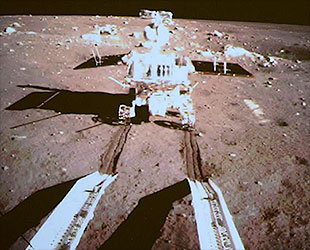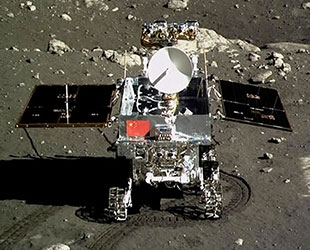December 14, 2013 — Beijing, the Bay of Rainbows Sea of Rains here, the Jade Rabbit has landed.
China on Saturday (Dec. 14) achieved its first-ever moon landing, placing a four-legged probe and six-wheeled lunar rover on the surface of Earth's nearest celestial neighbor. The feat established China as only the third country in the world to land a spacecraft on the moon, after the United States and former Soviet Union.
China's Chang'e 3 unmanned lander touched down at 7:11 a.m. CST (1311 GMT or 9:11 p.m. Beijing time) at Mare Imbrium, also known as the Sea of Rains (or Showers), a basaltic lava plain in the northwest quadrant of the moon as viewed from Earth. A screen in Beijing mission control gave the landing coordinates as 19.51° W, 44.12° N.
The landing site was east of what Chinese space program officials had said was the target, Sinus Iridum, or the Bay of Rainbows, and it was not immediately made clear if that was by plan or happenstance.
The probe's autonomous landing relied on onboard optical and microwave sensors to guide the spacecraft during its final descent from about 330 feet (100 meters) above the surface. At about 15 feet (4.5 meters), the lander's engine cut off and Chang'e 3 free fell the remainder of the way to the ground to avoid kicking up lunar dust.
Chang'e 3, which is the third in a series of lunar missions named after a goddess from Chinese folklore, is the first spacecraft to land on the moon since the Soviet Union's Luna 24 probe 37 years ago. By coincidence, Saturday's landing occurred 41 years to the day after the last humans walked on the moon during the Apollo 17 mission in 1972.
With the Chang'e 3 lander safely on the surface, attention turned to deploying the 5-foot (1.5 meter) rover mounted atop the probe. A public poll named the rover Yutu, or the "Jade Rabbit," after the lunar goddess' long-eared pet.

China's Chang'e 3 rover, Yutu, or Jade Rabbit, rolls onto the lunar surface beginning its three months studying the moon. (CCTV) |
After several hours of being charged atop the lander and establishing communications with Earth, the 310-lbs. (140-kilogram) rover descended to the surface by rolling down ramps lowered from the lander. The rover's six wheels first touched the lunar regolith at 2:35 p.m. CST (2035 GMT or 0435 Beijing time Dec. 15).
At some point, the Chang'e 3 lander and Yutu rover were expected to photograph each other, in part to reveal the red and golden Chinese flag emblazoned on their chassis.
But the Chang'e 3 mission is about more than flags and rover tracks. Both the lander and rover are equipped with cameras and science instruments to study the chemical composition of the surface and observe the area in which it landed.
Powered by two solar panels, the rover is outfitted with a sensor-tipped robotic arm and a ground-penetrating radar instrument mounted to its underbelly. The latter will enable the first direct study of the structure and depth of the lunar soil down to a depth of about 100 feet (30 meters).
The rover also carries x-ray and infrared spectrometers to analyze the elemental composition of lunar samples.

China's Yutu rover, as photographed by the Chang'e 3 lander, on the surface of the moon, Dec. 15, 2013. (CNSA/CCTV) |
Designed to explore Mare Imbrium for at three months, the Yutu rover will spend the two-week long lunar nights in a "sleep mode," its instruments being warmed by a nuclear radioisotope heater unit.
The Chang'e 3 mission was launched on Dec. 1 (Dec. 2 Beijing time) on a Long March 3B rocket from the Xichang Satellite Launch Center in China's southwest region. The spacecraft entered orbit around the moon five days later to begin a week decelerating to lower its altitude from about 60 miles to 10 miles (100 to 15 kilometers) from where it began its final descent to the lunar surface on Saturday.
Chang'e 3 is the second phase in the China's stated plans for robotic lunar exploration, following surveying the moon from orbit and leading to the return of moon rock and dust samples to Earth.
The Chang'e 3 mission comes 10 years after China's first human spaceflight, Shenzhou 5 in October 2003. Currently focused on deploying a space station into Earth orbit by 2020, China's long range crewed spaceflight goals include landing astronauts ("taikonauts") on the moon.
